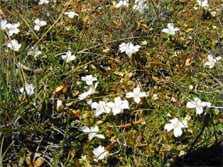Kettle hole plants
Introduction
Kettle holes are a feature of a glaciated landscape. Plants in these habitats have a remarkable lifecycle.Video
What are kettle holes?

When the glacier retreated a large block of ice got left behind
Kettle holes are a unique feature of a glaciated landscape. They are part-time wetlands, where the water rises and falls with the seasons and changing water table.

Covered by gravels (outwash) and insulated from the sun, the block melted very slowly to form a kettle hole

Kettle holes that contain water all year round are called kettle lakes
A kettle hole is formed by blocks of ice that are separated from the main glacier. The isolated blocks of ice then become partially or wholly buried in sediment. When the ice blocks eventually melt they leave behind holes or depressions that fill with water to become kettle hole lakes.
Ephemeral turfs
As each kettle hole is unique in its size, depth, location and water regime, so too are the plant communities (called ephemeral turfs) growing within them.
Because these sites can be either dry or full of water, their plants have a remarkable lifecycle: growing, flowering and seeding during the short time the water has receded.
Most plants found here are tiny versions (less than 3 cm high) of larger, more commonly found plants, such as miniature ferns, grasses, flowers, bulbs, bidibidi, rushes, mosses and even carnivorous plants.
Tiny ephemeral turfs under threat

An ephemeral turf ‘carpet’
Damage from vehicles, stock and rabbits is a major threat to the ephemeral turfs. Disturbance of the turfs can tip the balance and cause more drying, increase weed invasion and change the composition of the plant community.
Unfortunately, a number of kettle hole plants (approximately eight) are classified as threatened.
Once this damage occurs it is unlikely that they can be returned to their original state.
By educating visitors to the importance and fragility of these ecosystems, ephemeral turfs have a greater chance of remaining intact.
